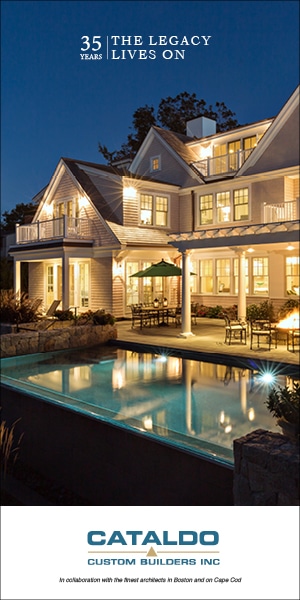
Navigating the nuances
Cape Cod Home / Spring 2018 / Home, Garden & Design, People & Businesses, Recreation & Activities
Writer: Bill O'Neill / Photographer: Dan Cutrona
Navigating the nuances

Cape Cod Home / Spring 2018 / Home, Garden & Design, People & Businesses, Recreation & Activities
Writer: Bill O'Neill / Photographer: Dan Cutrona
The new Sandwich harbormaster’s building is anchored in function and form
It’s no easy thing to construct a new building at the water’s edge in a historic district in Cape Cod’s oldest town, but Sandwich had dire need for a new harbormaster’s building. A storm in 2015 brought over six inches of water into the old office, which was located at the end of a pier. The damage forced clerical staff to work off site, and the harbormaster and his deputy to work out of their trucks for two months. “The old building was tiny,” says Mick Dunning, who’s been deputy harbormaster since 2015. “We had four of us in a narrow building that was about 10 by 40. It wasn’t very well insulated, and during storms and moon tides the walkway flooded 6 or 8 inches.”
An unusually high tide in January 2018 flooded the old harbormaster’s building—again. Looking down, literally, on the old building, the staff was high and dry in the new building, which opened in late 2016.
The harbormaster’s staff oversees the operation of the Sandwich Marina, which is on the southside of the Cape Cod Canal, close to the canal’s east entrance. The marina has 80 slips, about half of them contracted for commercial purposes by fishing crews and charter boats and the other half rented by recreational boaters. There’s also space for transient boaters to spend a night or two as they pass through the canal on trips up and down the East Coast. The old building is in the middle of the marina, which had its benefits, but at high tide boats that were nearby would block the view of the other side of the marina. The new building, on a bluff at the complex’s edge, offers a commanding view of marina activities. Being close to the water is a necessity for the staff, but also a charcteristic that created some design challenges.

Tarja McGrail of Coastal Engineering (which has offices in Sandwich, Orleans and Nantucket) was the project manager from the beginning. She oversaw a design of the stormwater drainage and septic systems intended to have minimal impact on the harbor. McGrail also worked closely with David DeConto, director of natural resources for the Sandwich Conservation Commission, when considering the landscape design program. Together they collaborated to choose native plantings that require less fertilization, irrigation as well as being more tolerant of the salty environment.
Tim Sawyer, the project architect, faced challenges that were “almost endless.” The marina property is owned by the Army Corps of Engineers (ACE) and leased to the town, so the ACE monitored the design process, as did the conservation and historic commissions.
“To make it more tricky, much of the site is in a flood zone,” says Sawyer, a project manager and associate architect with Brown Lindquist Fenuccio & Raber of Yarmouth Port. “The majority of the site is pretty tight to the edge of the water, so there were only a few places the building could be.” Sawyer goes on to say, “We pride ourselves on waterfront-type buildings and all the permitting issues and code implications that go along with it. They’re interesting projects and usually satisfying projects.”
The new building is adjacent to the public boat ramp and was designed to serve as a welcoming gateway to the marina, whether people arrive by land or sea.
“Waterfront buildings in New England have a particular aesthetic, especially on Cape Cod, and they have a particular scale,” says Sawyer. “We were trying to work within that. Some of the vernacular that you’re working with are gabled forms at a residential scale, even though it’s a commercial building. You’re not trying to make it look like a residence. It’s kind of a hybrid of the two.”
The building’s classic materials include white cedar shingle walls and an asphalt shingle roof—“a very familiar palette of materials,” says Sawyer. “It’s very recognizable as Cape Cod construction.”

One of the building’s most striking features is a second-floor balcony that calls to mind the prow of a ship. The balcony merges form and function, in that it allows the harbormaster and his deputy to step from their offices and see and hear activity in the marina.
“With municipal buildings, the budgets are tight, so you have to be very deliberate where you try to create a little extra flair,” says Sawyer. “We saw that as an opportunity to play with the design a little and create some interest.”
“It was a very enjoyable project,” says Chris Raye, vice president of Builders Systems Inc., the contractor, which has offices in Sandwich and Auburn. “The building has a lot of roof line and lots of jogs and configurations that created a lot of trim detail. It was a beautiful building to work on.”
The open interior, with work space for staff members, a conference room and a small lunchroom on the first floor, has an inner lobby that conveys the building’s purpose to the public. A compass rose is inlaid into the wooden floor. To the left is a display case housing an award-winning model of the Rose Standish, which was the first ship to travel through the Cape Cod Canal on July 29, 1914.
It took Carlo DiPersio a year to build the 65-inch model of the paddle steamship. He donated it to the new office in memory of David Whearty, who was the harbormaster from 2012 until his unexpected death in 2015, two months before the groundbreaking for the new building. Whearty, who started working at the marina as a teenager, had been a driving force in the push for a new headquarters.

The building committee shared the original blueprints of the Rose Standish with Paula Drury, interior designer with Brown Linquist Fenuccio & Raber. She had the prints converted to a large scale graphic mural that becomes a focal point as you enter the lobby.
Constructed adjacent to the headquarters building is a new garage workspace, featuring large bays with overhead hoists that allow staff members to work on vehicles and dock sections in a controlled environment. To make room for the new headquarters building, a playground was moved closer to the water.
“Even before this project, I used to take my kids to that playground every weekend when they were younger, so I was very familiar with the site,” says Sawyer. “That gave me a unique perspective that you don’t always get with an architect. Intimately understanding and knowing a site is quite a bit different from coming into a project somewhat cold where you’re trying to learn everything you can about it.”
“Sometimes when I go to the supermarket, I’ll swing by the harbor for the memories,” says Raye.
“It’s nice to bring family and friends there,” says McGrail, who uses the boat launch with her family. “You feel good saying ‘I worked on this project.’”
A video case study of the project can be seen on Coastal Engineering’s web site, coastalengineeringcompany.com




